#royal edinburgh asylum
Photo

Assigned Causes of Insanity
Table from the Annual Report of the Royal Edinburgh Asylum for the Insane, 1874.
[ID: A printed table from an old book, titled "Assigned Causes of Insanity." The causes are categorized as "Physical" or "Moral", and counts are given for males, females, and total. In the "Physical" category: "Congenital, epilepsy, intemperance, childbirth, suppurating breast, over-work, affection of lungs, breaking arm, want of food, falls, hemmorhage, severe cold, lactation, a severe storm, cerebro-spinal affection, secret vice, stomach disease, derangement of female health, softening of brain, paralysis, neuralgia, fever." In the "Moral" category: "Disappointment, domestic affliction, fright, mental worry, depression of spirits, over excitement, quarrels, religious excitement, irritation, grief, anxiety, loss of a ship, embarrassment of affairs." There is also a "Predisposing" category consisting of "Previous attacks" and "Hereditary predisposition", and an entry for "Unknown". END ID]
#mental health history#old books#vintage books#causes of insanity#united kingdom#scotland#1870s#royal edinburgh asylum
29 notes
·
View notes
Text



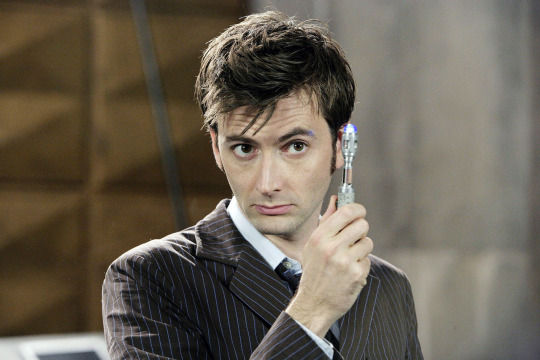

Happy Birthday David Tennant born April 18th 1971.
Born David McDonald, David was brought up in Bathgate and Ralston and he knew from an early age he wanted to be an actor, at the age of three, Tennant told his parents that he wanted to become an actor because he was a fan of Doctor Who. His parents were very religious people and tried to discourage him but he himself admits to being “absurdly single minded” in his ambitions, educated at Ralston Primary and Paisley Grammar School. He acted in school productions throughout primary and secondary school
At aged only 11 the respected Scottish actress Edith MacArthur told his parents he would become a successful stage actor, David attended the Royal Scottish Academy of Music and Drama on saturdays and passed an audition age 16 to enter the academy as one of its youngest students. From there he took several stage roles at Dundee Repertory Theatre.
His first big break came in 1994 when he was cast in a lead role in the Scottish drama ‘Takin’ Over the Asylum’. He then moved to London where his career thrived and, most notably, he spent several years as a member of the Royal Shakespeare Company, and took lead roles in the critically acclaimed TV dramas ‘Blackpool’ and 'Casanova’ and of course the role which catapulted him into “stardom” as Doctor Who.
Since leaving Doctor Who in 2010 his career has gone from strength to strength, with lead roles in films such as Fright Night, Harry Potter and the Goblet of Fire and St. Trinian’s 2: The Legend Of Fritton’s Gold and in TV series including Spies of Warsaw and the very popular Broadchurch which has just finished it’s third run on ITV. Tennant still treads the board regularly, as well as being in demand for films and TV work, he is married to Georgia Moffett who he met when they co-starred in Doctor Who, her father is actor Peter Davison who took was also Doctor Who in the 70’s!
David’s career has gone from strength to strength, with lead roles in films such as Fright Night, Harry Potter and the Goblet of Fire and St. Trinian’s 2: The Legend Of Fritton’s Gold and in TV series including Spies of Warsaw and the very popular Broadchurch which was remade in the U.S as Gracepoint, which showed his ability to adapt his accent to a different audience.
During the pandemic over the past couple of years David has kept himself busy withthe likes of Ducktales, which as an animated series he has not had to break restrictions.
We saw him in the thriller Livtenko, about the Russian dissident poisoned in London, he was also in the drama series Inside Man, which, in my opinion was just a bit silly, although well acted silliness.
David has recently been filming the second season of Good Omens with Michael Sheen in Edinburgh, it should hit the small screens on Amazon Prime this summer. He has no less than seven projects on the go according to Imdb, so is as popular as ever.
101 notes
·
View notes
Text
Scottish-Jewish ‘madness’?:
An examination of Jewish admissions to the royal asylums of Edinburgh and Glasgow, c.1870-1939
0 notes
Text
Haunted Cities: Discover the World's Most Spine-Chilling Destinations
Are you a thrill-seeker with a fascination for the supernatural? If so, you're in for a treat! We've compiled a list of the most haunted cities across the globe, where ancient folklore, ghost stories, and unanswered questions come together to create an eerie atmosphere. From the dark streets of Prague to the abandoned corridors of Poveglia Island, these spine-chilling destinations are sure to send shivers down your spine. So, grab your ghost-hunting gear and get ready for an unforgettable adventure!
1. Prague, Czech Republic: Where Ghosts Roam the Historic Streets
Prague, the capital city of the Czech Republic, is a treasure trove of haunted spots. As you wander through the historic streets, you might encounter the Headless Templar on Liliova Street or hear the strangled screams of demons in Houska Castle, famously known as the "Gates of Hell." These spine-chilling encounters will transport you to a world beyond the living.
2. Changi Beach, Singapore: Unveiling the Dark Secrets of Old Changi Hospital
Adjacent to the picturesque Changi Beach lies the hauntingly sinister Old Changi Hospital. During World War II, this place served as a prison for 50,000 Allied prisoners who reportedly endured unimaginable torture. Visitors claim to hear echoes of screams that resonate through the area, a chilling reminder of the past.
3. Sighisoara, Romania: Delve into the Birthplace of Dracula
For fans of Bram Stoker's legendary novel, Dracula, Sighisoara is a must-visit. This historic Transylvanian city is the birthplace of Vlad the Impaler, the brutal Prince of Wallachia who inspired the iconic vampire. Explore his childhood home, which now houses a tiny torture museum, or venture into the eerie, creaky stairwell of Holy Trinity Church after dark.
4. London, U.K.: Royal Spirits and Ghosts of Monks
London, a city steeped in history, harbors its fair share of paranormal activity. The Tower of London, infamous for its gruesome past, is haunted by the spirits of royalty. Meanwhile, Westminster Abbey is said to be frequented by ghostly monks. If you're brave enough, venture into Highgate Cemetery, but beware of the vampire lurking on Swain's Lane.
5. Edinburgh, U.K.: Unearth the Ghostly Secrets of Scotland's Capital
Edinburgh, the capital of Scotland, offers a dark and haunting experience. Edinburgh Castle, perched atop a hill, conceals ghost-ridden dungeons and a chilling past. For a spine-chilling encounter, dare to explore Real Mary King's Close, an underground network of streets where victims of the Black Plague were quarantined and left to die.
6. Baguio, Philippines: Unveiling the Dark History of Diplomat Hotel and Laperal White House
In the scenic city of Baguio, two haunted locations stand as testaments to a violent past. The abandoned Diplomat Hotel bears witness to the atrocities of World War II, with the spirits of war crimes victims lingering in its halls. Another chilling spot is the Laperal White House, known for its violent history of torture and murder.
7. New Orleans, Louisiana: A Tapestry of Ghostly Tales
New Orleans, with its rich and tragic history, is a hotbed of ghostly activity. Yellow fever epidemics and devastating fires have left their mark, fueling the city's ghost lore. In Jackson Square, located in the French Quarter, the sounds of the dead are said to reverberate. Don't miss the infamous LaLaurie Mansion, home to Madame LaLaurie, one of the world's most notorious serial killers.
8. Poveglia Island, Venice, Italy: The Epitome of Haunted Destinations
Venice, known for its masks and gondolas, also boasts Poveglia Island, often hailed as "the most haunted place in the world." This abandoned island was once home to an exiled colony of plague victims and later served as a sinister asylum. Ghost hunters flock to this eerie island in search of paranormal encounters.
9. Canberra, Australia: Haunted Halls and Mysterious Figures
The Old Parliament House in Canberra is not only a symbol of political history but also a hotspot for ghostly encounters. Visitors have reported sightings of former prime ministers wandering the halls, adding an eerie twist to this iconic landmark. Hotel Kurrajong, where Prime Minister Ben Chifley suffered a heart attack in 1951, is also rumored to be haunted.
10. San Antonio, Texas: Supernatural Tales in the Home of the Alamo
San Antonio, Texas, known as the home of the Alamo, has its fair share of supernatural stories. The grounds of San Fernando Cathedral come alive after sundown, with shadowy figures and spirits making their presence felt. Visitors often report sightings of hooded monks and men dressed in black, adding an extra layer of intrigue to this historic city.
Conclusion: Embark on a Haunting Adventure
If you're a horror enthusiast or simply seeking an adrenaline rush, these haunted cities offer the perfect vacation destinations. From encountering the Headless Templar in Prague to exploring the ghostly dungeons of Edinburgh Castle, each city has its own unique blend of history, folklore, and spine-chilling encounters. So, pack your bags, embrace the unknown, and embark on an unforgettable journey into the world's most haunted cities. Just remember, you might not be alone...
1 note
·
View note
Text
Going to the Chapel of Love
When Janet’s nephew Tom was 16 years old, he came home one day and told his mom she needed to go sign a paper giving him permission to join the military. It came as a surprise but with Tom never being much of a student, Pam granted her blessing and now 22 years later, he is still active and having a very successful career.
I will probably get all this wrong, but will try. Tom is a member of a branch of the British Army called The Rifles. At some point in their history, they were the Royal Green Jackets so you might be able to tell in my photos that their pants are black but their jackets are dark green. It is an infantry unit but is also the bugler unit — I just love that combination — so they get to train and perform a lot of impressive rites and traditions.
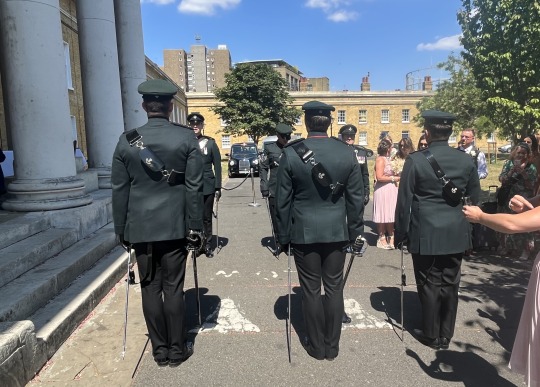
Early in his career, they took Tom, someone with no musical experience at all, and taught him to play the bugle. He has had some awesome assignments because of it, too — being assigned to travel with the highest ranking officers just in case they have a fancy dinner and need a bugler and playing in the Tattoo in Edinburgh and other such ceremonial events. Most memorable, though, at least to the family members, is when he played Last Post at his grandfather’s funeral (Janet’s Dad’s funeral). On the other hand, it has certainly not all been fun and games as he has had deployments to Afghanistan and Iraq and some very challenging training courses.
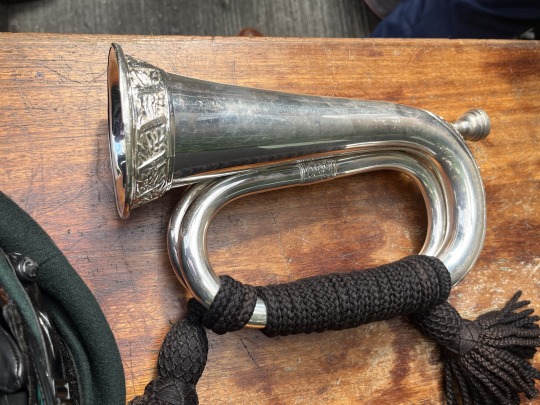
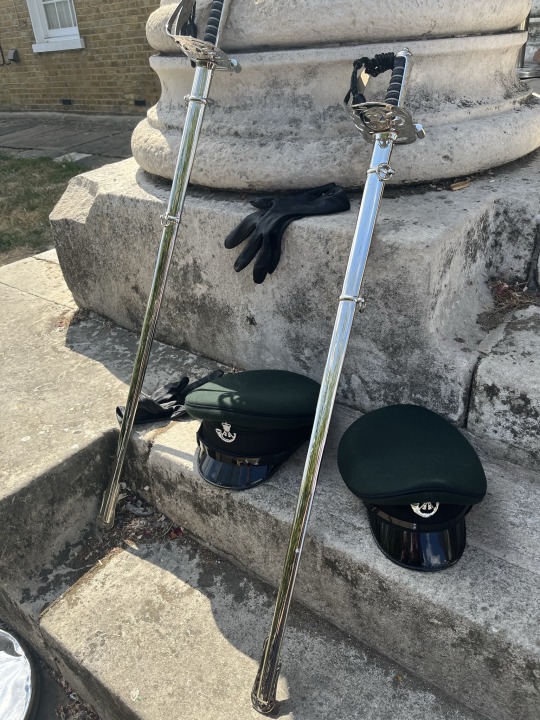
Friday was wedding day…..or shall I say Friday was finally wedding day. The last of Pam’s sons to get married, Tom and Hannah have been together since 2006, engaged since 2017. I think from the very beginning of any of us meeting Hannah, we all felt that they were perfectly matched.
The wedding was at noon but we were encouraged to get there early. Janet, Babs and I just took a London black cab to the most interesting venue, Asylum Chapel. From the website:
“Established in or around 1827, Caroline Gardens Chapel in Peckham formed the heart of London’s largest complex of almshouses (charitable housing) originally known as the Licensed Victuallers’ Benevolent Institution Asylum (LVBI). The Grade II listed site was not a psychiatric facility – here, ‘asylum’ traditionally meant ‘sanctuary’ — and was actually a home for elderly, retired pub landlords.
Residents were entitled to a small weekly cash payment, coal, medical care and medicine. With the welfare state still being over 100 years from creation, almshouses were an important part of life, offering impoverished Georgian and Victorian elders the only alternative to destitution or the workhouse.”

The building was heavily damaged during WWII but miraculously, the stained glass windows survived. It sat unused until restoration talks began in 1977 but fizzled out. In 2010, the arts community discovered it and began hosting shows and art exhibits. The non-profit running it now has received both lottery and heritage funds to work on the roof and repair one of the stained glass windows. It was a really cool place for a wedding on a warm sunny day and the addition of Tom and his military friends in their dress uniforms along with attention-grabbing bugling, added to the beauty. But beyond that, I think everyone in the room was just so happy for Tom and Hannah to finally be able to get married. They deserved a perfect day and from my perspective, they certainly got it.

After the wedding, we all went outside and had drinks and sausage rolls (it’s England, after all!) and the obligatory photo shoot went on and on. Eventually everyone made their way over to the reception venue, mostly on foot, including the bride and groom! And then for the rest of the day — and until the venue had to close at midnight, we were told — people ate, drank, danced (including Babs dancing with her grandson, the groom), laughed, cried, sang, gave speeches, made toasts, had caricatures drawn and of course, those who could, bugled. What’s not to love?




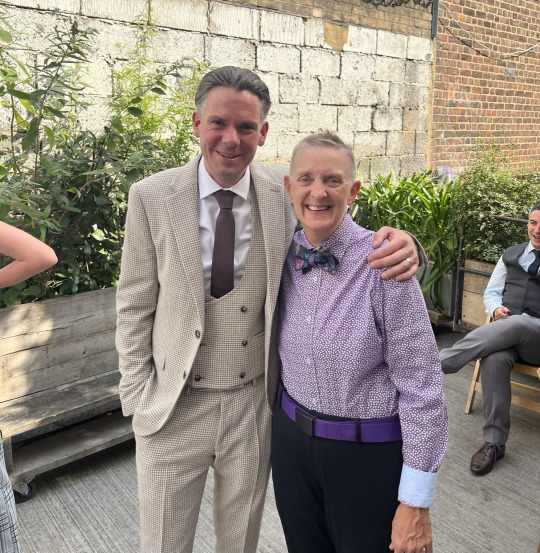
I loved the suit in which Tom changed into after his dress uniform.


0 notes
Photo
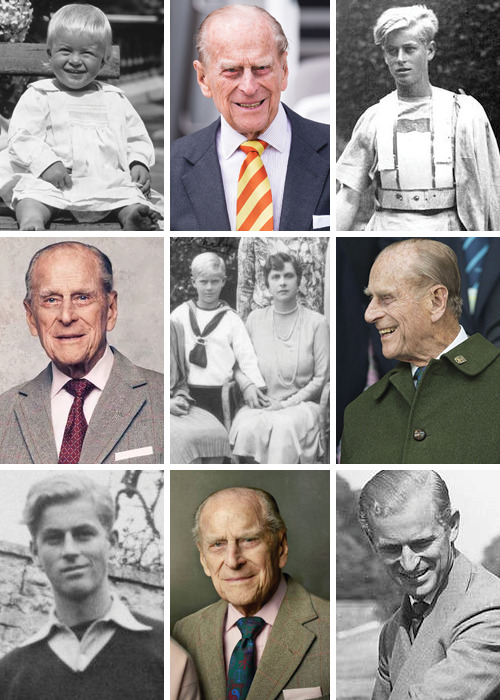

HRH THE PRINCE PHILIP, DUKE OF EDINBURGH (June 10th 1921 - April 9th 2021)
Born Prince Philip of Greece and Denmark, Philip was the youngest son of Prince Andrew of Greece and Denmark and Princess Alice – a great-granddaughter of Queen Victoria. After the Greco-Turkish war, his family was exiled and Philip was carried to safety in a fruit box, before settling in France. Philip has stated he thinks of himself as Danish, although he has lived in England for most of his life.
At the age of six, he travelled to England to live with his maternal grandmother, Victoria Mountbatten. His mother was committed to an asylum, his father moved to Monte Carlo, and his sisters married German Noblemen. During Hitler’s rise to power, several of these noblemen became entwined with the Nazi party. While Philip was attending Gordonstoun, in Scotland, he attended a Nazi funeral after the death of his sister.
Philip joined the Royal Navy in 1939 and served during the Second World War. He received a number of military awards during the war and became one of the young first lieutenants in the Royal Navy. While at the Royal Naval College, Philip was introduced to his distant relatives, King George VI, Queen Elizabeth, and their two daughters, Elizabeth and Margaret. After this meeting, Elizabeth began to send letters to Philip regularly and, in 1946, they became engaged. In 1947, in preparation for the official announcement, Philip discarded his titles and became Philip Mountbatten, a British subject.
The day before his wedding, Philip, became a His Royal Highness and was made the Duke of Edinburgh, Earl of Merioneth, and Baron Greenwich of Greenwich. He married Elizabeth in a televised wedding at Westminster Abbey, attended by none of his family. In the following years, they had two children: Charles and Anne. Until the death of George VI, Philip remained at work with the Navy, predominantly stationed in Malta.
In 1957, Elizabeth granted Philip the title of Prince of the United Kingdom, making him HRH Prince Philip. The couple later had two more children: Andrew and Edward. During the following years, Philip became patron of over 800 organisations and regularly toured countries alongside his wife and, later, children. Philip is a keen sportsman, and has enjoyed polo, carriage driving, yachtsman, and flying. He also loves painting.
Known for being down-to-earth, and having made plenty of rude and often racist remarks, Philip is a divisive figure. Despite this, he is beloved by his grandchildren and appears to be close to his great-grandchildren. After the dawn of the 21st Century, he began to suffer from ill health and had to miss a number of pivotal moments. He is the longest serving consort of all time and half of the only British reigning couple to celebrate a 70th Wedding Anniversary. In 2017, Philip retired from royal duties. He still accompanied the Queen on various engagements and was seen at family moments, including weddings, christenings, and Christmas.
#philip#the death of the duke of edinburgh#mine#royaltyedit#not saying I made this edit in 2016 but not saying I didn't either
145 notes
·
View notes
Note
The courts of England and Wales, supported administratively by Her Majesty's Courts and Tribunals Service, are the civil and criminal courts responsible for the administration of justice in England and Wales.
The United Kingdom does not have a single unified legal system—England and Wales has one system, Scotland another, and Northern Ireland a third. There are exceptions to this rule; for example in immigration law, the Asylum and Immigration Tribunal's jurisdiction covers the whole of the United Kingdom, while in employment law there is a single system of employment tribunals for England, Wales, and Scotland but not Northern Ireland. Additionally, the Military Court Service has jurisdiction over all members of the armed forces of the United Kingdom in relation to offences against military law.
The Court of Appeal, the High Court, the Crown Court, the County Court, and the magistrates' courts are administered by Her Majesty's Courts and Tribunals Service, an executive agency of the Ministry of Justice.
The Supreme Court of the United Kingdom is the highest appeal court in almost all cases in England and Wales. Before the Constitutional Reform Act 2005 this role was held by the House of Lords. The Supreme Court is also the highest court of appeal for devolution matters, a role previously held by the Judicial Committee of the Privy Council.
The Supreme Court has a separate administration from the other courts of England and Wales, and its administration is under a Chief Executive who is appointed by the President of the Supreme Court of the United Kingdom.
The Supreme Court (UKSC or SCOTUK) is the final court of appeal in the United Kingdom for all civil cases, as well as for criminal cases originating in England, Wales and Northern Ireland. It also hears cases of the greatest public or constitutional importance affecting the whole population.
The Court usually sits in the Middlesex Guildhall in Westminster, though it can sit elsewhere and has, for example, sat in the Edinburgh City Chambers, the Royal Courts of Justice in Belfast, and the Tŷ Hywel Building in Cardiff.
The United Kingdom has a doctrine of parliamentary sovereignty, so the Supreme Court is much more limited in its powers of judicial review than the constitutional or supreme courts of some other countries. It cannot overturn any primary legislation made by Parliament. However, as with any court in the UK, it can overturn secondary legislation if, for an example, that legislation is found to be ultra vires to the powers in primary legislation allowing it to be made.
Further, under section 4 of the Human Rights Act 1998, the Supreme Court, like some other courts in the United Kingdom, may make a declaration of incompatibility, indicating that it believes that the legislation subject to the declaration is incompatible with one of the rights in the European Convention on Human Rights. Such a declaration can apply to primary or secondary legislation. The legislation is not overturned by the declaration, and neither Parliament nor the government is required to agree with any such declaration. However, if they do accept a declaration, ministers can exercise powers under section 10 of the Human Rights Act to amend the legislation by statutory instrument to remove the incompatibility or ask Parliament to amend the legislation.
As authorised by the Constitutional Reform Act 2005, Part 3, Section 23(1), the Supreme Court of the United Kingdom was formally established on 1 October 2009 and is a non-ministerial government department of the Government of the United Kingdom. Section 23 of the Constitutional Reform Act limits the number of judges on the Court to 12, though it also allows for this rule to be amended, to further increase the number of judges, if a resolution is passed in both Houses of Parliament.
It assumed the judicial functions of the House of Lords, which had been exercised by the Lords of Appeal in Ordinary (commonly called "Law Lords"), the 12 judges appointed as members of the House of Lords to carry out its judicial business as the Appellate Committee of the House of Lords. Its jurisdiction over devolution matters had previously been exercised by the Judicial Committee of the Privy Council.
The current President and Deputy President of the Supreme Court are Lord Reed of Allermuir and Lord Hodge respectively.
Thanks.
11 notes
·
View notes
Text
Court Archetypes: The Dethroned Royals
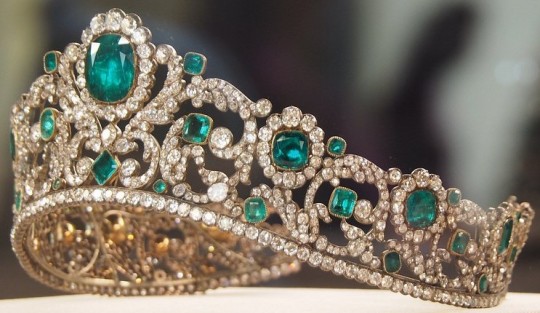
So obviously I was inspired by The Crown to write this post. Pre-WWI Royalty has always piqued my interest, my favourites of course being the Romanovs who I've been obsessed with since I was like six. But the tragic ends and fates of royals who have been deposed have always caught my interest. So in this post, also inspired by an ask sent in by @therealcommanderbear , we'll be discussing displaced/dethroned royalty and their fates.
Usually when we see this in fiction we have 3 categories.
The Fighter

This displaced monarch fights for what is theirs. They will attempt to win or win back their thrones and kingdoms that are rightfully theirs.
Edward IV: Edward IV was displaced in 1470. He fled for his life after meeting the combined forces of his brother the Duke of Clarence and the Earl of Warwick. He escaped by boat with his close friends and his younger brother, almost drowning at sea before landing in Burgundy. His family escaped to sanctuary where his son, Edward was born. After a chat with the Duke of Burgundy who was kinsman and ally of the king, he returned to England after six months and smashed his enemies in battle at Barnet and Tewkesbury.
Henry Tudor/VII: Henry went into exile at fourteen after the fall of his house. He lived in Brittany with his uncle, waiting in the wings until there was opportunity to return to England. In 1483, an offer was made to let him come home and take up his Dukedom. But in the chaos after the death of the current king, the offer was forgotten. Henry attempted to invade with help from the Duke of Buckingham but was beaten by the weather. He returned in 1485 and won the throne, installing the House of Tudor and ending the Plantagenet line.
Margaret of Anjou & Edward of Westminster: After Henry V died, the kingdom was left to his young son Henry VI. He was not the best king, most adept at praying and sleeping. During the unrest that would eventually unseat him, his wife Margaret took control of their armies and fought for the throne. She was exiled but returned with a Scottish army. She lost some battles and won a few but was eventually beaten and the crown was lost. But after a shock defection from an enemy, the Earl of Warwick, she and her son aimed to take back the throne. The kingdom was won by Warwick yet the Queen and Prince were trapped in France thanks to bad weather. By the time they landed, Warwick was dead, the York king was back and they were effectively fucked. They made a dash to Wales hoping to find support but thanks to a flooded river they were forced to fight at Tewkesbury where the prince died and the queen was captured.
The Refugee

Some royals escape from the coups and revolutions that displace them. They usually flee to family members in other countries or allies in hope that they will shelter them or help them.
Alice of Battenburg & Prince Philip of Edinburgh (Greece & Denmark): After the Greco-Turkish war, things in Greece were getting though for the royal family. After much consideration, the coup that took over exiled Prince Andrew, Princess Alice and their four daughters and their infant son. Famously little Prince Philip was sleeping in a converted fruit crate while this happened. They went to Germany, France and England hopping about without a home. The princesses married into mainly German families and Philip worked in the Navy. In 1952, he married Princess Elizabeth heir to the English throne and shed his foreign titles in favour of a British one. Alice of Battenburg returned to Greece where she founded a nunnery, often selling her jewels to fund the order. During civil unrest, Alice came to England in order to live out her final years at Buckingham Palace.
Dowager Empress Maria Fyodorovna: The mother of Tsar Nicholas II fled Russia during the Revolution. She made it England on invitation from her sister Queen Alexandra. She lobbied to get asylum for the rest of her family but before it could be agreed, it was too late. She returned to Denmark where she died years later.
Marie-Therèse, Madame Royale and Duchess of Angoulême: The only living daughter of Marie Antoinette and Louis XIV was imprisoned along with her mother and brother during the Revolution. After the death of her parents, she was exchanged for French prisoners and sent to her mother's home country of Austria. During the brief restoration, she returned to France and served as Duchess of Angoulême.
Charles II: After the English Civil War, Charles I acted stupidly and got his head cut off leaving us with that cunt Oliver Cromwell. During the time where Cromwell was invading and insulting my country and being a general warty bollocks, the queen had escaped to France with her children. Her daughter Henrietta was married to the Duc of Orléans and her son Charles got busy with the ladies of the court. But Charles was invited back to be king during the Restoration where he chilled on his throne for a good lot of years where he slept around, partied and generally acted awesome. (*plays a loop of Horrible Histories' Charles II's Rap*)
The Tragic

And yet sometimes the story does not end so happily. Revolutions try to destroy the object of their opposition, mainly taking violent options.
Marie Antoinette, Louis XVI & Louis-Charles (Louis XVII): Probably the most famous revolution, the French Revolution claimed the lives of most the immediate Royal family. Louis XVI died first, guillotined after standing trial. His wife Marie Antoinette followed a few months later. Louis-Charles the Dauphin and the accepted king to loyal monarchists was kept in a dank dark cell, bullied into announcing lies that would further smear the reputations of his parents including a testimony that his mother had molested him. Louis-Charles died in the cell, thanks to the damp cell hampering his already ill heath.
Tsar Nicholas II, Tsarina Alexandra, Grand Duchesses Olga, Tatiana, Marie, Anastasia and Tsarevitch Alexei: The Russian Royal family was dethroned during the Russian Revolution and imprisoned by the Bolsheviks. The royal family was sent north to Siberia to live in exile under house arrest. They remained positive thinking that somebody would rescue them be it the White Army or their cousins in England. They believed that they would be banished abroad and sewed their corsets full of jewels. The family was awoken one night to "take a photograph" in the basement of the House of Special Purpose in order to prove they were alive. The family waited along with some close friends, the Tsarina and the crippled Tsarevitch seated. Eleven gunmen entered the chamber and began firing at the family. The men died quickly but thanks to the jewels sewn into their corsets, the women were harder to kill. Once they were dead, the revolutionaries dumped the bodies in a nearby wood separating them so that if anybody found them, they would not think that it was the royal family. During the late half of the 20th century, the bodies were found and identified before being buried.
#court archetypes#court archetypes: dethroned royals#alice of battenburg#Prince philip#Charles ii#edward iv#philippe d'orléans#tsarina alexandra#tsarevich alexei#tsar nicholas ii#grand Duchess olga#grand duchess Tatiana#grand duchess marie#grand duchess Anastasia#royal court#royalty#royal#writing advice#writing advice writing reference#writing reference writing resources#writing references#writing resources writing advice#writing resources#writing royalty#fantasy nobility#writing nobility#nobility#bolshevik revolution#french revolution#Versailles
700 notes
·
View notes
Text
Royal Edinburgh Asylum? Indian!
(Sorry, Goodness Gracious Me is embedded in my brain, and this is immediately where I went)
I finished listening to Olivette Otele’s African Europeans (reccomended read, btw) and had the thought that I’d never tried to cross-reference donors to the Royal Edinburgh Asylum (REA) with the Legacies of British Slave-Ownership database. That hasn’t brought anything up so far, though the nature of the records means that this absolutely should not be taken to say that no money from slavery went into the REA. However, a totally different colonial link came up, via an 1836 report detailing the finances of the REA from foundation to that time.
It gives the totals of all donations up to that time:

I’m not going to go into the shillings and pence, but of the individual donations received, of £5986 recevied, £1708 was from India - that’s 29% of all individual donations. The total of all donations, including grants from government, was £15,695 - which makes those donations from India 11% of all donations to the REA.Fees from patients were the largest single source of income, amounting to £38,042 over that time; the total of all income for REA was £57,735. Doing the maths on that, the money from India was 3% of the all the money that the REA had got, ever.
There has been a fair amount written about the enthusiastic Scottish participation in the British Empire, so this probably shouldn’t be as surprising as I found it.
It was certainly not a constant flow of money and seems to follow the pattern of donations in general with very significant variations from year to year: for example, total donations were £1032 in 1820, then £123 in 1821. The majority of the donations from India seem to have come from four big funding drives (I’m using the place names as they are in the document, not modernising):
1809: £408 from Madras, £83 from Ceylon
1811: £185 from Calcutta
1812: £283 from Bombay
My first thought was that these had been prompted by someone with a connection to Edinburgh. I can’t find anything about the Dr Christie associated with the Ceylon donation. The 1812 Bombay donation has Scottish links, but not obviously Edinburgh ones; it’s “remitted by Charles Forbes, Esq” and the Charles Forbes with connection to Bombay at this time is either this guy or his son, whose connections are with Aberdeen. The largest donation was from “Hon J Duncan”, and reading the photo of his tombstone he was from Forfar:

(You could write a whole essay on the iconography of that tombstone; you’ve got romanticism, classicism, colonialism, whatever the academic term is for “won’t someone think of the children!” etc etc)
I suspect that the donation from Madras “remitted by Dr James Anderson” was this James Anderson, medical degree from Edinburgh. A “Dr Adam Burt, Bengal” is listed as a member of the Royal College of Physicians in Edinburgh in an 1815 almanack, so that’s probably the Calcutta donation “remitted per Dr Adam Burt”.
As an aside, it may well be the same Adam Burt who wrote “On The Dissection Of The Pangolin” in 1789, which finishes with this magnificent humblebrag:

Then I found a reference to the donation being talked about in the Bombay Courier, dated August 10th 1811, and it’s right there on the front page:

I’m going to transcribe it, because of a combination of fuzziness and multiple long ‘s’:
Edinburgh Lunatic Asylum
To the Honorable Jonathan Duncan, Governor of Bombay
The managers of the Edinburgh Lunatic Asylum beg leave to inclose to the Honorable Jonathan Duncan an address to the public on that institution and a short account of its origin. These they earnestly reccomend to an attentive consideration; and they may also further add, that the Edinburgh Lunatic Asylum is intended, not merely as a local, but as a National Institution, into which the insane will be admitted, on the same terms from every part of Britain and where they may receive the advice and assistance of any practitioners in Edinburgh whom their relations may chuse to employ.
Those whose circumstances do not enable them to pay Medical Practitioners will be supplied gratuitously both with adviace and Medicines; the person or the Parish who sends them being charged only with a very low Board for their Maintainence, and with the expence of such Clothing as the Managers may find it absolutely necessary to furnish to them.
Where a Patient, sent to the Asylum is in such circumstances, that his Relations are willing to pay for the best accomodation, he will not only be attended by any Medical Practitioners whom they may chuse to appoint, but be under the immediate care also of his own Servants, and have a House and Garden within the walls of the Asylum appropriated to his own use.
With this view; the ingenious Architect Mr Reid, to whose gratuitous exertions the Edinburgh Lunatic Asylum is very much indebted, has introduced into the plan three small houses, each in the middle of a small garden, and conveniently accomodated for the reception of a single individual, subjected to Mental Derangement, whose Relations may wish, that while the care of his health is entrusted to those Physicians whom they have employed with a view to his recovery, the care of his person should be confided to such Keepers or Servants as they may chuse to appoint.
Thus the Edinburgh Lunatic Asylum, if Money can be procured to complete the whole of the intended Plan, will afford Conveniences, in the Cure of Insanity, which are not perhaps to be obtained in any similar institution in Europe. On this ground, the Managers flatter themselves with the hope, that they may receive some assistance from the Benevolent and Patriotic in every part of the British Empire. And money is only wanted from the Public to complete the building; for, after that is finished, there can be little doubt, that the institution will support itself.
Edinburgh - Februrary 1808
-----
Subscriptions will be received at the Office of Messrs Forbes and Co where the Address to the Public and Plan of the Institution alluded to in the foregoing letter to the Hon’ble Governor may be seen.
Bombay, 1st August 1811
There follows a list of 30 named subscribers.
So - they sent a mail shot half way across the world! Actually an incredibly canny thing to do - there were rich Scots in India, whose heart and purse strings could be pulled on. Possibly also some self-interest; Europeans who became “subject to Mental Derangement” in India were generally shipped home asap, and it wasn’t until 1818 that there was dedicated provision for the returnees in the UK.
Also, note the date sent from Edinburgh - February 1808. So the liklihood is that all four of the big donations from India (inc Ceylon) resulted from the same mail shot, but there were different amounts of time in transport/languishing in the governor’s in-tray as unimportant.
A similar tug-heartstrings-for-money had appeared in the Scots Magazine and Edinburgh Literary Miscellany in November 1807 - “Address to the Public, respecting the Establishment of a Lunatic Asylum at Edinburgh.” It’s much longer than the one in the Bombay Courier, and noteable in the difference in emphasis. Both want the reader to be benevolent to the poor; but only the Bombay version stresses patriotism. The Bombay version stresses the luxury end of the provision; the Edinburgh version stresses that you could go and visit friends in the asylum “without trouble or expence” and that charges would be “comparatively moderate”. India was where the rich Scots with money to spare were.
When you think of colonies as machines for funneling money and resources to the colonising country, you tend to think of business, industry and military, not charity. But “supporting charity back home” could be another avenue for this resource transfer, and this example shows that it could be significant amounts of money.
#colonialism#British Empire#British India#East India Company#history of psychiatry#history the Tories don't want you to know about#Scotland and the Empire
2 notes
·
View notes
Text

Admissions, Re-Admissions, Discharges, and Deaths, from January 1, 1865 to December 31, 1874.
From the Annual Report of the Royal Edinburgh Asylum for the Insane, 1874.
#mental health history#medical history#old books#vintage books#royal edinburgh asylum#united kingdom#scotland#history#1870s
0 notes
Text




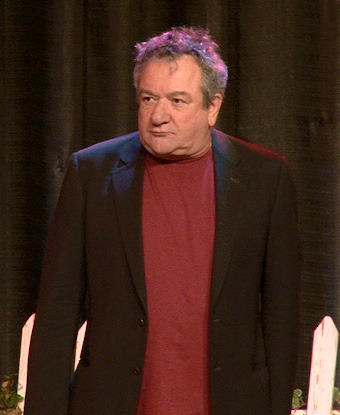
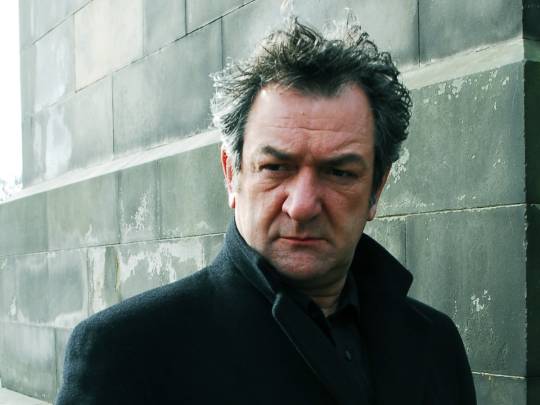
Happy Birthday Kenneth Campbell "Ken" Stott, born on October 19th 1954 in Edinburgh.
One of my favourite actors, as hard-drinking Detective hero of Ian Rankin's popular book he was Inspector John Rebus to me. Ken's Father was Scottish and a teacher, his mum a Sicilian, he went to the famous George Herriots school before going onto to Mountview Theatre School, where the distinguished actor Sir John Mills was president. Fellow Scot Douglas Henshall was also a student of the school. Before leaving Edinburgh Stott had been in a band called Keyhole some of the members of the group would later join the Bay City Rollers.
Ken went on to work with the Royal Shakespeare Company but the pay was poor and he subsidised his earnings by selling double glazing. His first TV role was in Secret Army for the BBC, parts in TV shows throughout his career have included, Taggart (of course) The Singing Detective, London's Burning, Your Cheatin' Heart and Silent Witness. He was insome good films too, The Debt Collector (with Billy Connolly) , Shallow Grave, (with Ewen MacGregor) and Plunkett & Macleane (with Robert Carlyle).
My favourite shows of Ken's have been the brilliant BBC Scotland series, Takin' Over the Asylum in which starred as Double Glazing salesman, but aspiring disc jockey
with David Tennant and Angus Macfadyen,The ITV series The Vice was also a cracking series where he played DI Pat Chappel and The BBC show Messiah, where again he played a cop, DCI Red Metcalfe where he learned sign language for scenes with his screen wife,and Rebus of course, when the show was resurrected in 2006, Stott was a first choice for many as D.I John Rebus, John Hannah had the role in the first incarnation, mainly due to it being made by his own production company.
On film Ken is probably best known for his role as the Dwarf, Balin in The Hobbit trilogy. He is a popular choice for voice work, as narrator for series such as Trawlermen, a documentary following North Sea trawlers, and Send in the Dogs, following the work of Police Officers and their canine partners.
One of my favourite stories about Ken Stott echoes the no nonsense approach of Rebus, on stage during Arthur Miller's A View From The Bridge, he halted the play when a group of teenage schoolkids were misbehaving and disturbing the show, switching from his stage American to his native Scots accent he told the teacher responsible for the children to remove them, or the play would not go on.
The house lights were switched on and there was then a 15-minute stand-off as discussions took place with the offending youngsters.
The audience took the side of Stott and even resorted to chanting 'out, out, out' in extraordinary scenes. Eventually the three culprits and an embarrassed teacher was forced to creep away before the play resumed at the Duke of York's Theatre.
Recently Ken was in the TV series Devils playing professor Wade in the show. Look out for The Dig, a decent Netflix film about an archaeologist dig in England in 1938 also starring Ralph Fiennes.
Ken reprised his role as Chief Superintendent Bob Toal in the second series of Irvine Welsh's Edinburgh set cop show Crime.
Nominated for many awards, he was lifted two Scottish Baftas and a Laurence Olivier Award.
13 notes
·
View notes
Text
Insane asylums filled up with patients who had had influenza, people suffering variously from profound depression, mania, paranoia, or hallucinations. “The number of admissions reached unprecedented proportions,” reported Albert Leledy at the Beauregard Lunatic Asylum, at Bourges, in 1891. “Admissions for the year exceed those of any previous year,” reported Thomas Clouston, superintending physician of the Royal Edinburgh Asylum for the Insane, in 1892. “No epidemic of any disease on record has had such mental effects,” he wrote.
In 1893, Althaus reviewed scores of articles about psychoses after influenza, and the histories of hundreds of his own and others’ patients who had gone insane after the flu during the previous three years. He was perplexed by the fact that the majority of psychoses after influenza were developing in men and women in the prime of their life, between the ages of 21 and 50, that they were most likely to occur after only mild or slight cases of the disease, and that more than one-third of these people had not yet regained their sanity.
The frequent lack of respiratory illness was also noted in the even deadlier 1918 pandemic. In his 1978 textbook Beveridge, who had lived through it, wrote that half of all influenza patients in that pandemic did not have initial symptoms of nasal discharge, sneezing, or sore throat.
The age distribution is also wrong for contagion. In other kinds of infectious diseases, like measles and mumps, the more aggressive a strain of virus is and the faster it spreads, the more rapidly adults build up immunity and the younger the population that gets it every year. According to Hope-Simpson, this means that between pandemics influenza should be attacking mainly very young children. But influenza keeps on stubbornly targeting adults; the average age is almost always between twenty and forty, whether during a pandemic or not. The year 1889 was no exception: influenza felled preferentially vigorous young adults in the prime of their life, as if it were maliciously choosing the strongest instead of the weakest of our species.
Then there is the confusion about animal infections, which are so much in the news year after year, scaring us all about catching influenza from swine or birds. But the inconvenient fact is that throughout history, for thousands of years, all sorts of animals have caught the flu at the same time as humans.
When the army of King Karlmann of Bavaria was seized by influenza in 876 A.D., the same disease also decimated the dogs and the birds. In later epidemics, up to and including the twentieth century, illness was commonly reported to break out among dogs, cats, horses, mules, sheep, cows, birds, deer, rabbits, and even fish at the same time as humans.
Beveridge listed twelve epidemics during the eighteenth and nineteenth centuries in which horses caught the flu, usually one or two months before the humans. In fact, this association was considered so reliable that in early December 1889, Symes Thompson, observing flu-like illness in British horses, wrote to the British Medical Journal predicting an imminent outbreak in humans, a forecast which shortly proved true.
During the 1918–1919 pandemic, monkeys and baboons perished in great numbers in South Africa and Madagascar, sheep in northwest England, horses in France, moose in northern Canada, and buffalo in Yellowstone.
There is no mystery here. We are not catching the flu from animals, nor they from us. If influenza is caused by abnormal electromagnetic conditions in the atmosphere, then it affects all living things at the same time, including living things that don’t share the same viruses or live closely with one another.
-- Arthur Firstenberg, The Invisible Rainbow: A History of Electricity and Life
1 note
·
View note
Text
The Ghost of You – Updated
I just posted a short exposition-y chapter of my property developer Richie & ghost Eddie fic. It involves a mention of Eddie’s death, but it isn’t graphic or anything.
You can read it on AO3 HERE or I’ve posted it under the cut as well.
Preview:
Edward James Kaspbrak was born in 1909, to Frank James Kaspbrak and Sonia Jennifer Kaspbrak (neé Stewart) in Edinburgh, Scotland. He was 9 lbs 6. His father worked as an alienist at the Royal Edinburgh Asylum before he’d left to serve on the Western Front, and his mother was a homemaker. His childhood was about as conventional as possible, given the circumstances. He barely saw his father, who worked eye-wateringly long hours at the psychiatric hospital before leaving for France in 1916. He’d spent most of his childhood attached to his mother’s side, fingers sticky with homemade jam, leaving strawberry smudges on the stiff cotton of her skirt.
@constantreaderfool @xandertheundead
Edward James Kaspbrak was born in 1909, to Frank James Kaspbrak and Sonia Jennifer Kaspbrak (neé Stewart) in Edinburgh, Scotland. He was 9 lbs 6. His father worked as an alienist at the Royal Edinburgh Asylum before he’d left to serve on the Western Front, and his mother was a homemaker. His childhood was about as conventional as possible, given the circumstances. He barely saw his father, who worked eye-wateringly long hours at the psychiatric hospital before leaving for France in 1916. He’d spent most of his childhood attached to his mother’s side, fingers sticky with homemade jam, leaving strawberry smudges on the stiff cotton of her skirt.
Edward James Kaspbrak lost his father when he was twelve. He’d served on the front lines at the Western Front, dodged artillery shells and nursed sick men back to life with nothing but dirty gauze and sheer willpower. He’d survived that, but he couldn’t survive the tumour that grew malignant and engorged in his liver. He’d died from cancer, the treatable kind. The chorus of ‘I’m fine, I’m fine’s’his father sang out every time he winced in pain when he’d returned home at the beginning of 1918 had been lies. He’d died, emaciated and pallid, in a hospital bed with Eddie at his side.
“Look after your mother, Eddie”
“I will, daddy”
His mother changed soon after his father died. She had always been protective, had winced and jittered every time Eddie did something she did something she thought was dangerous. These ostensibly dangerous things ranged from riding his bike too fast down the hill to drinking his water too fast when he’d come in from playing outside, skin still sizzling with warmth.
“Careful, Eddie-bear! You’ll choke!”
“It’s only water, Ma”
Eddie watched passively, helplessly, as his mother descended into health anxiety so extreme she’d feed him medication from his father’s left over, and swiftly depleting, supply. She’d fed him anti-psychotics, extract of the calabar bean to stave of general paralysis, a psychiatric condition that Eddie was sure he didn’t have. His limbs moved just fine. He still took the pills.
When he’d coughed up blood aged eighteen, bleary eyed and thick tongued, she’d taken him to the hospital. She’d paid for Eddie to be poked and prodded by physicians, who concluded that he’d been poisoned. His mother was arrested the same day, and committed to the same institution her husband worked at. Her diagnosis was generalised hysteria. She was unhinged, hyper emotional, and something about her womb shifting in her torso, an evil animalistic organ that polluted her mind. Eddie wasn’t listening to the alienist who explained it all to him.
Eddie visited her twice. Once when he’d graduated from medical school, and once when he’d finally plucked up the courage to tell her that he’d been in a committed, but secret, relationship with a school teacher for three years.
She’d screamed like a wounded dog, and Eddie swore he’d never return.
Eddie Kaspbrak became Dr Edward Kaspbrak in 1934. He’d scraped through medical school by the skin of his teeth, but he’d done it. Becoming a doctor seemed like the most natural decision in the world, like Eddie had sleepwalked through the application process. His education flashed before his eyes like lightning, and it felt like he’d taken a single breath between arriving at the University of Edinburgh Medical School and starting his residency at Stobhill Hospital in Glasgow. Eddie had initially considered becoming an psychiatrist, an aborted attempt at walking in his father’s footsteps whilst also learning to cure his mother’s delusions. He’d quickly abandoned that idea.
3rd September 1939. Eddie was 30 years old. Prime Minister Neville Chamberlain announced that ‘this morning the British Ambassador in Berlin handed the German Government a final note stating that unless we heard from them by 11 o'clock, that they were prepared at once to withdraw their troops from Poland, a state of war would exist between us.’ Britain stood still, rocked by the prospect of plunging themselves into yet another half-decade of unbridled fear, poverty and uncertainty. Dr Kaspbrak spilt his coffee all over his legs.
When he got home, his partner Rupert was weeping quietly in front of a fire that flickered pathetically, before disappearing in a puff of smoke that curls gently towards the ceiling.
Rupert left Scotland for France in 1941. Eddie doesn’t wave him off from the station. They can’t risk it. When Rupert walked out of Eddie’s small cottage for the last time, Eddie slammed the door shut and howled until his lungs burn. Bitter thoughts of tearful women waving to their husbands with hankerchiefs in their hands, children crying as the train pulls out of the station, their mothers hands gripping their soldiers in an iron-vice. Eddie couldn’t have that, despite how desperately he craved it.
He wished Rupert was going somewhere – anywhere – but France. Not France. Not again.
After a serious bombing raid on the Scottish capital city in late 1940, swift plans were made for the evacuation of children from Edinburgh to the Highlands and Islands, and the Isle of Skye. Eddie applied for the role of resident physician for a small group of children travelling to a disused school building.
When he’d heard that he’d been successful, and he’d gotten the job, he’d driven to the Royal Edinburgh Asylum, and stood outside the gates for three hours. Breathing. Staring.
He didn’t walk into the building.
He’d left Edinburgh in February 1941 with a small suitcase and a hole in his heart.
Rupert Brodie dies Brigadier R. Brodie in 1943. The last letter that Eddie receives from Rupert arrives in Skye three weeks after Rupert’s death. It’s mottled with blood and dirt. Eddie can barely read the scrawled handwriting, but he spends hours staring at it once the children have gone to bed.
Eddie enjoyed his job. He spent his days cleaning scraped knees, setting one or two broken wrists or toes, giving the children their booster vaccinations, that sort of thing. Mindless busy work, he supposed. Nothing too taxing. He was one of two adult staff, the other an older woman with a kind face and gentle eyes. The children were pleasant, for the most part. Eddie, who had never spent much time around children even when he himself was one, adored children. The innocence, the playfulness, the eagerness to learn, to experience, to grow. He’d grown particularly fond of one child in particular, a small boy with timid eyes that reminded Eddie so much of himself that he’d had to sit down the first time he’d seen Henry Bowers throwing sticks in the direction of the small boy. The small boy had done nothing, just wrapped his arms around his skinny torso and trembled, hands in front of his face. Eddie had sent the loutish Bowers boy to bed without any supper.
The days became weeks, weeks became months and months became years. The end of 1944 sees the British government announce that the end was in sight, that it was safe for arrangements for the return of evacuated children to be set in motion. The children screamed and cheered with joy, and they had celebrated that evening with copious amounts of strawberry jelly and half melted ice-cream.
Dr Edward Kaspbrak got stabbed as he slept four days before he was due to return to Edinburgh. The letters and pictures he had recieved from Rupert over the years 1941-1943 were strewn across the room, crumpled and torn.
The police give up trying to find the culprit almost immediately, refusing to accept that a child or an older woman with such a kind face could commit such a heinous crime. Eddie’s body isn’t transported back to Edinburgh, and is instead buried in the grounds of the house. A grave marked only by an anonymous cross, small and unassuming.
The cross is soon buried under a dense thicket of thistles.
The children and Mrs McGethen leave the house in the spring of 1945.
Eddie’s body is left alone in the windy wilds of the Scottish moors.
#reddie#eddie kaspbrak#richie tozier#richie tozier x eddie kaspbrak#the ghost of you#thefutureisbright#ao3
15 notes
·
View notes
Text
STATES VISITED BY GHOST ADVENTURES
Alabama :
1.05 – Sloss Furnaces: Birmingham, Alabama, US 4.07 – Vulture Mine: Wickenburg, Arizona, US
Alaska :
Arizona :
2.05 –Birdcage Theater: Tombstone, Arizona, US 4.20 – Jerome Grand Hotel: Jerome, Arizona, US 6.03 – The Copper Queen Hotel & The Oliver House: Bisbee, Arizona, US 10.08 – Apache Junction: Apache Junction, Arizona, US 10.09 – Return to Tombstone: Tombstone, Arizona, US 11.7 – Grand Canyon Caverns: Peach Springs, Arizona, US 12.8 – Hell Hole Prison: Yuma, Arizona, US 12.9 – The Domes: Casa Grande, Arizona, US 12.12 – Stardust Ranch: Buckeye, Arizona, US 13.3 – Palace Saloon: Prescott, Arizona, US 15.10 – Phelps Dodge Hospital: Ajo, Arizona, US
15.11 – The Slaughter House: Tucson, Arizona, US 16.4 – Old Gila County Jail and Courthouse: Globe, Arizona, US
Arkansas :
4.10 – Fort Chaffee: Fort Smith, Arkansas, US
California :
2.01 – Preston Castle: Ione, California, US 2.03 – La Purisima Mission: Lompoc, California, US 3.07 – Linda Vista Hospital: Boyle Heights, Los Angeles, California, US 3.10 – Clovis Wolfe Manor: Clovis, California, US 4.08 – USS Hornet: Alameda, California, USNovember 5, 2010 4.11 – Amargosa Opera House: Death Valley Junction, California, US 4.15 – Pico House Hotel: Los Angeles, California, US 4.23 – Sacramento Tunnels: Sacramento, California, US 5.03 – Old Town San Diego: San Diego, California, US 5.04 – Winchester Mystery House: San Jose, California, US 6.04 – The National Hotel: Nevada City, California, US 6.05 – Return to Linda Vista Hospital: Los Angeles, California, US 7.03 – Point Sur Lighthouse: Big Sur, California, US 7.08 – Brookdale Lodge: Brookdale, California, US
7.09 – Tor House: Carmel, California, US 7.15 – Market Street Cinema: San Francisco, California, US 7.17 – Glen Tavern Inn: Santa Paula, California, US 8.03 – Tuolumne General Hospital: Sonora, California, US 8.05 – Yost Theater & Ritz Hotel: Santa Ana, California, US 8.08 – Alcatraz: San Francisco, California, US 9.1 – Sharon Tate Ghost/The Oman House: Los Angeles, California, US 9.6 – Heritage Junction: Santa Clarita, California, US 9.7 – Fort MacArthur Museum/Battle of Los Angeles: Los Angeles, California, US
9.11 – Whaley House: San Diego, California, US 10.1 – Queen Mary: Long Beach, California, US 11.6 – Los Coches Adobe: Soledad, California, US, Salinas, California, US 11.8 – Haunted Hollywood: Los Angeles, California, US 12.1 – Black Dahlia House: Los Angeles, California, US 12.2 – Secret Scientology Lab: Los Angeles, California, US 12.3 – Bracken Fern Manor/Tudor House: Lake Arrowhead, California, US 12.5 – Chinese Town of Locke: Walnut Grove, California, US 12.6 – Star of India: San Diego, California, US 12.11 – Return to Winchester Mystery House: San Jose, California, US 13.4 – Reseda House of Evil: Los Angeles, California, US 13.5 – Dorothea Puente Murder House: Sacramento, California, US 13.10 – Zalud House: Porterville, California, US 14.2 – Freak Show Murder House: Los Angeles, California, US 14.5 – Silent Movie Theater: Los Angeles, California, US 14.10 – The Viper Room: West Hollywood, California, US 16.1 – Ripley’s Believe It or Not: Hollywood, California, US 16.2 – The Alley of Darkness: North Hollywood, California, US 16.3 – Kennedy Mine: Jackson, California, US 16.5 – Hotel Léger: Mokelumne Hill, California, US 17.2 – Westerfeld House: San Francisco, California, US 17.3 – Crisis in Oakdale: Oakdale, California, US 17.5 – Terror in Fontana: Fontana, California, US 17.6 – Riverside Plane Graveyard: Riverside, California, US
Colorado :
4.05 – Stanley Hotel: Estes Park, Colorado, US 6.02 – Peabody-Whitehead Mansion: Denver, Colorado, US 7.07 – Cripple Creek"Cripple Creek, Colorado, US
Florissant, Colorado, US 13.1 – Colorado Gold Mine: Idaho Springs, Colorado, US 14.6 – Exorcism in Erie: Erie, Colorado, US 15.4 – Museum of the Mountain West: Montrose, Colorado, US
Connecticut :
3.05 – Remington Arms Factory: Bridgeport, Connecticut, US 6.06 – The Galka Family: Granby, Connecticut, US
Delaware :
Florida :
1.04 – The Riddle House: Royal Palm Beach, Florida, US 2.02 – Castillo De San Marcos: St. Augustine, Florida, US
Georgia :
2.07 – Moon River Brewing Company: Savannah, Georgia, US 9.10 – Haunted Savannah: Savannah, Georgia, US
Hawaii :
Idaho :
1.08 – Idaho State Penitentiary: Boise, Idaho, US 11.11 – Lava Hot Springs Inn: Lava Hot Springs, Idaho, US 15.3 – Albion Normal School: Albion, Idaho, US 17.1 – Idaho State Reform School: St. Anthony, Idaho, US
Illinois :
5.01 – Ashmore Estates: Ashmore, Illinois, US 7.02 – Excalibur Nightclub: Chicago, Illinois, US
Indiana :
7.05 – Black Moon Manor: Greenfield, Indiana, US 8.10 – Thornhaven Manor: New Castle, Indiana, US 9.9 – Fox Hollow Farm: Carmel, Indiana, US
Iowa :
4.13 – Villisca Axe Murder House: Villisca, Iowa, US 11.1 – Edinburgh Manor: Scotch Grove, Iowa, US
Kansas :
10.6 – Sallie House: Atchison, Kansas, US
Kentucky :
1.01 – Bobby Mackey’s Music World : Wilder, Kentucky, US 4.03 – Return to Bobby Mackey’s: Wilder, Kentucky, US 4.04 – Waverly Hills Sanatorium: Louisville, Kentucky, US 4.25 – Kentucky Slave House: Maysville, Kentucky, US 5.08 – Rocky Point Manor: Harrodsburg, Kentucky, US
Perryville, Kentucky, US 8.11 – Battle of Perryville: Field Hospitals"Perryville, Kentucky, US
Louisiana :
2.04 – Magnolia Plantation: Natchitoches, Louisiana, US
7.14 – New Orleans: New Orleans, Louisiana, US 9.2 – The Myrtles Plantation: St. Francisville, Louisiana, US
Maine :
Maryland :
Massachusetts :
1.02 – Houghton Mansion : North Adams, Massachusetts, US 4.18 – Valentine’s Day Special(Longfellow’s Wayside Inn): Sudbury, Massachusetts, US 4.19 – Salem Witch House/Lyceum Restaurant: Salem, Massachusetts, US 5.05 – Lizzie Borden House: Fall River, Massachusetts, US 8.06 – Haunted Victorian Mansion: Gardner, Massachusetts, US 13.9 – Dumas Brothel: Butte, Montana, US
Michigan :
Minnesota :
7.04 – The Palmer House: Sauk Centre, Minnesota, US 10.7 – Nopeming Sanatorium: Duluth, Minnesota, US
Mississippi :
7.18 – Kings Tavern: Natchez, Mississippi, US
Missouri :
7.10 – Union Station: Kansas City, Missouri, US 8.04 – Missouri State Penitentiary: Jefferson City, Missouri, US 8.07 – The Exorcist House: Bel-Nor, Missouri, US 10.2 – Lemp Mansion: St. Louis, Missouri, US 11.9 – Odd Fellows Asylum: Liberty, Missouri, US 15.5 – Pythian Castle: Springfield, Missouri, US 15.6 – The Titanic Museum: Branson, Missouri, US
Montana :
9.4 – Bannack Ghost Town: Dillon, Montana, US 11.2 – Old Montana State Prison: Deer Lodge, Montana, US 13.6 – Hotel Metlen: Dillon, Montana, US 13.8 – Twin Bridges Orphanage: Twin Bridges, Montana, US 13.9 – Dumas Brothel: Butte, Montana, US
Nebraska :
Nevada :
3.06 – Old Washoe Club and Chollar Mine: Virginia City, Nevada, US 4.09 – La Palazza Mansion: Las Vegas, Nevada, US 4.16 – Goldfield: Goldfield, Nevada, US 4.17 – Bonnie Spring Ranch: Blue Diamond, Nevada, US 4.22 – Madame Tussauds Wax Museum: Las Vegas, Nevada, US 5.02 – Mizpah Hotel: Tonopah, Nevada, US 5.07 – Return to Virginia City: Virginia City, Nevada, US
6.07 – The Riviera Hotel: Las Vegas, Nevada, US 7.16 – Goldfield Hotel: Redemption: Goldfield, Nevada, US 8.01 – Pioneer Saloon: Goodsprings, Nevada, US
Sandy Valley, Nevada, US 8.09 – Mustang Ranch: Clark, Nevada, US 9.12 – Overland Hotel and Saloon: Pioche, Nevada, US 11.10 – Clown Motel and Goldfield High School: Tonopah, Nevada, US
Goldfield, Nevada, US 12.4 – Return to the Riviera: Las Vegas, Nevada, US 12.10 – Nevada State Prison: Carson City, Nevada, US 12.13 – The Haunted Museum: Las Vegas, Nevada, US 13.2 – Mackay Mansion: Virginia City, Nevada, US 15.8 – Eureka Mining Town: Eureka, Nevada, US 15.9 – Sin City Exorcism: Las Vegas, Nevada, US 16.7 – The Washoe Club: Final Chapter: Virginia City, Nevada, US 17.7 – Gates of Hell House: Las Vegas, Nevada, US
New Hampshire :
New Jersey :
1.06 – Abandoned Psychiatric Hospital: Cedar Grove, New Jersey, US
New Mexico :
9.8 – St. James Hotel: Cimarron, New Mexico, US 11.5 – Haunted Harvey House: Las Vegas, New Mexico, US 14.4 – Double Eagle Restaurant: Mesilla, New Mexico, US
Las Cruces, New Mexico, US 14.7 – Skinwalker Canyon: Ojo Amarillo, New Mexico, US 14.8 – Upper Fruitland Curse: Upper Fruitland, New Mexico, US 16.8 – Lewis Flats School: Deming, New Mexico, US
New York :
3.08 – Execution Rocks Lighthouse: Port Washington, New York, US 4.02 – Rolling Hills Asylum: Bethany, New York, US 5.06 – Letchworth Village: Haverstraw, New York, US 7.13 – Sailor’s Snug Harbor: Staten Island, New York, US 9.3 – George Washington Ghost/Morris Jumel Mansion: Manhattan, New York, US,Smithtown, New York, US
North Carolina :
North Dakota :
13.11 – Dakota’s Sanatorium of Death: San Haven, North Dakota, US
Ohio :
3.04 – Ohio State Reformatory: Mansfield, Ohio, US 3.09 – Prospect Place: Trinway, Ohio, US 9.13 – Old Licking County Jail: Newark, Ohio, US
Oklahoma :
10.3 – Zozo Demon: Oklahoma City, Oklahoma, US 14.1 – Stone Lion Inn: Guthrie, Oklahoma, US 14.3 – Samaritan Cult House: Guthrie, Oklahoma, US
Oregon :
6.01 – Shanghai Tunnels: Portland, Oregon, US 15.1 – Golden Ghost Town: Golden, Oregon, US 15.7 – Wolf Creek Inn: Wolf Creek, Oregon, US 16.6 – Enchanted Forest: Turner, Oregon, US
Pennsylvania :
2.06 – Eastern State Penitentiary: Philadelphia, Pennsylvania, US 3.02 – Pennhurst State School: Spring City, Pennsylvania, US 4.01 – Gettysburg: Gettysburg, Pennsylvania, US 4.06 – Hill View Manor: New Castle, Pennsylvania, US
Rhode Island :
South Carolina :
5.10 – Old Charleston Jail: Charleston, South Carolina, US
South Dakota :
Tennessee :
4.24 – Hales Bar Marina and Dam: Haletown, Tennessee, US 4.27 – Loretta Lynn’s Plantation House: Hurricane Mills, Tennessee, US 10.5 – Bell Witch Cave: Adams, Tennessee, US 11.4 – Old Lincoln County Hospital: Fayetteville, Tennessee, US
Texas :
4.21 – Yorktown Hospital: Yorktown, Texas, US 7.01 – Central Unit Prison: Sugar Land, Texas, US
Huntsville, Texas, US 7.11 – Crazy Town: Mineral Wells, Texas, US 8.02 – Black Swan Inn: San Antonio, Texas, US 10.11 – Texas Horror Hotel: Seguin, Texas, US,San Antonio, Texas, US 13.12 – De Soto Hotel and Concordia Cemetery: El Paso, Texas, US 13.13 – Goatman’s Bridge: Denton, Texas, US
Utah :
4.26 – Tooele Hospital: Tooele, Utah, US 9.5 – Fear Factory: Salt Lake City, Utah, US 12.7 – Leslie’s Family Tree: Santaquin, Utah, US 13.7 – St. Ann’s Retreat: Logan Canyon, Utah, US 14.9 – Witches in Magna: Magna, Utah, US 14.11 – Asylum 49: Tooele, Utah, US 15.2 – Ogden Possession: Ogden, Utah, US 16.9 – Kay’s Hollow: Kaysville, Utah, US 17.4 – Tintic Mining District: Eureka, Utah, US
Vermont :
Virginia :
Washington :
4.14 – Kell’s Irish Pub Restaurant: Seattle, Washington, US 10.10 – Demons in Seattle: Bothell, Washington 11.3 – Manresa Castle: Port Townsend, Washington, US
West Virginia :
1.03 – Moundsville Penitentiary : Moundsville, West Virginia, US 3.01 – Ghost Adventures Live – The Trans-Allegheny Lunatic Asylum: Weston, West Virginia, US
Wisconsin :
Wyoming :
7.12 – Wyoming Frontier Prison: Rawlins, Wyoming, US
OTHER PLACES VISITED :
1.07 – Edinburgh Vaults: City of Edinburgh, Edinburgh, Scotland, UK] 2.08 – Ancient Ram Inn: Wotton-under-Edge, Gloucestershire, England, UK 3.03 – Poveglia Island: Venice, Veneto, Italy 4.12 – Olde Fort Erie: Fort Erie, Ontario, Canada 5.09 – Rose Hall: Montego Bay, St. James Parish, Jamaica
10.4 – Island of Dolls: Xochimilco, Mexico City, Mexico
#submission#zakbagans#zak bagans#ghost adventures#ghostadventures#dirtyblog#dirty blog#thedirtyblog#the dirty blog
11 notes
·
View notes
Text

Book: Heart of the Highlands: THE RAVEN
By April Holthaus
Series: Protectors of the Crown, Book #1 (Prequel)
Publisher: Grey Eagle
Overall Rating: 5 stars
Blog Rating: 5 Saltire Flags
Edinburgh, Scotland
Autumn 1529
Adelyn Scott, who was King Henry’s royal ward is on the run! She is both frantic and terrified being falsely accused of murdering her husband, Lord Charles Langston. He was a wicked, penniless, womanizing, Englishman who only married her for her dowry. He was murdered the evening after their nuptials. It was obvious he had female company other than his new wife and that is most likely who murdered him. Except everyone mistakenly believes it wasAdelyn and whoever did this knew she would be accused! So she goes to the only person who could possibly help her-her cousin, King James V of Scotland.
(Historical Fact King James V is the father of Mary Queen of Scots born 8 December 1542)
Adelyn Scott Knows she would be executed if she remained with King Henry who did not believe his own ward. Not surprising since she had always been treated more like a prisoner than a ward the entire time under his care. So she goes to Edinburgh castle pleading for asylum. This is where she meets the King’s first protector, the swoon worthy Eamon MacLeish. At first she was refused access to see King James until Eamon intercede’s with the Kings rude guard. Eamon informs the King that he thinks Adelyn is a royal ward by the necklace she was trying to hide. An identity that must be kept secret by Eamon, the King and Adelyn.
Eamon is immediately attracted to Adelyn but also feels a big need to safeguard this woman no matter what the cost. The attraction and chemistry between aAdelyn and Eamon quickly turns to love! At first the King is all for helping her, but he is more worried about his own people rebelling against him as civil war breaks out among the clans. Now he is setting up a secret troop of warriors to guard and protect him called “The Protectors of the Crown.”
Eamon had always been loyal and faithful to the King until he was going to give Adelyn back and put her in a very dangerous position. Eamon refuses to allow this to happen no matter what the cost. He now goes against his Kings wishes which makes him a traitor to the Crown, Now will he and Adelyn both be executed? Read and find out what happen to this star crossed couple who
April pens a quick, fast paced prequel eight years prior to the other books of the series. So even though this is the third book it’s the first book of the series. Fans of April Holthaus will definitely enjoy this book from start to finish,
Disclaimer: I received a complimentary copy from the author. I voluntarily agreed to do a fair review and blog. All thoughts, ideas and words are my own.
Heart of the Highlands by April Holthaus
1)The Raven - Prequel
2)The Beast
3)The Wolf
0 notes
Photo
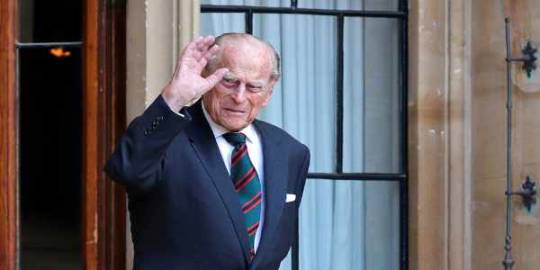
New Post has been published on https://freenews.today/2021/04/09/duke-of-edinburgh-husband-of-queen-elizabeth-dies-at-99/
Duke of Edinburgh, husband of Queen Elizabeth, dies at 99


Prince Philip, the Duke of Edinburgh and husband of reigning British monarch Queen Elizabeth II, has died at the age of 99. Buckingham Palace confirmed his death on April 9.
“It is with deep sorrow that Her Majesty The Queen has announced the death of her beloved husband, His Royal Highness The Prince Philip, Duke of Edinburgh. His Royal Highness passed away peacefully this morning at Windsor Castle,” the statement read. The Duke was married to the Queen for over 70 years, and was the longest-serving consort in British history.
Prince Philip was admitted to hospital on February 16, after feeling unwell, but was released a month later, having undergone a successful procedure for a pre-existing heart condition.
The son of Prince Andrew of Greece and Denmark and Princess Alice, Philip was born on the Greek island of Corfu in 1921, but primarily raised in Britain.
He renounced his right to the Greek and Danish thrones in 1947 and took his mother’s surname, Mountbatten. Philip married Elizabeth Windsor, a distant cousin, later that year – five years before her ascension to the British throne in 1952.
He became father to Prince Charles and grandfather to Prince Harry and Prince William. He was also father to Princess Anne and Princes Andrew and Edward.
The young Philip had a turbulent early life. His parents separated while the Duke was still a boy, and Princess Alice was diagnosed with schizophrenia and committed to an asylum in the late 1920s. As a child, Philip moved from Greece to France, to Britain, and then to Germany for his education, returning to the UK in the mid-1930s amid the rise of Nazism in Germany.
His biographers describe his time in Britain as calm, though tragedy struck the young royal in 1937 when his sister, Cecile, and her German husband, along with their family, were killed in a plane crash at Ostend.
A colorful character, Prince Philip’s forthright manner, political incorrectness, conservative political views and frequent public gaffes came to be a source of considerable embarrassment for the monarchy.
Among his many blunders, Philip once asked British expats in Dubai if they were “running away from something” and told the President of Nigeria, who was wearing national traditional dress, that he looked like he was “ready for bed.” In 1998, he told a cash-strapped student to consider living in a hostel to “save cash.”
“If you stay here much longer, you’ll go home with slitty eyes,” he told a British student studying in China in 1986. He also referred to places as near and far as Stoke-on-Trent and Beijing as “ghastly.”
He was also known for some self-deprecating humor, remarking on his marriage in 1999 that the Queen “has the quality of tolerance in abundance.”
Philip retired from public engagements in 2017 after seven decades of service. Before Queen Elizabeth’s coronation the Duke served with the Royal Navy from January 1940 to the end of World War II.
In addition to his royal duties, he also served in the role of president of the World Wildlife Fund between 1981 and 1996, as well as engaging in other philanthropic endeavors.
The Duke was involved in a road accident in early 2019 when he collided with another car and his Land Rover flipped over. He had been suffering ill health in recent years and was admitted to hospital multiple times, including for a hip operation in 2018 and an infection in 2017, and most recently for treatment of a “pre-existing condition” in 2019.
As the Duke aged, the British tabloid press often speculated about his deteriorating health. They reported in 2011 that he had given up his hobby of shooting after receiving a stent in his heart, and as the coronavirus pandemic spread in 2020, they reported on his isolation in Windsor Castle, watchful for any signs of ill health.
However, both Philip and the Queen received their vaccinations against the virus in January.
Think your friends would be interested? Share this story!
Source
1 note
·
View note